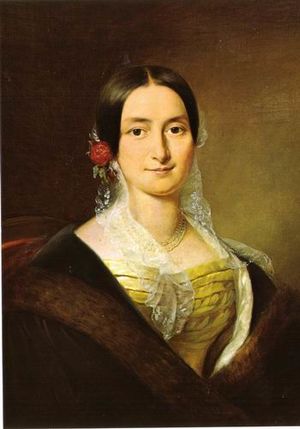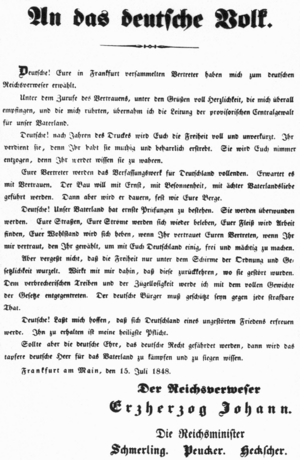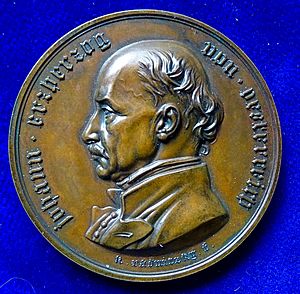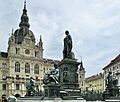Archduke John of Austria facts for kids
Quick facts for kids Archduke John |
|
|---|---|
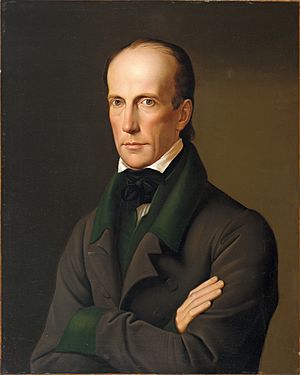
Portrait by Leopold Kupelwieser, 1828
|
|
| Imperial Regent of the German Empire | |
| In office | 12 July 1848 – 20 December 1849 |
| Predecessor | Ferdinand I of Austria (President of the German Confederation) |
| Successor | Francis Joseph I of Austria (President of the German Confederation) |
| Born | 20 January 1782 Florence, Grand Duchy of Tuscany |
| Died | 11 May 1859 (aged 77) Graz, Styria, Austrian Empire |
| Burial | Schenna Castle, Tyrol |
| Spouse | Anna Maria Josephine Plochl |
| Issue | Franz, Count of Meran |
| House | Habsburg-Lorraine |
| Father | Leopold II, Holy Roman Emperor |
| Mother | Maria Luisa of Spain |
| Religion | Catholic |
| Signature |  |
Archduke John of Austria (German: Erzherzog Johann Baptist Joseph Fabian Sebastian von Österreich; born January 20, 1782 – died May 11, 1859) was an important member of the House of Habsburg-Lorraine. He was an Austrian army leader and later a special ruler (called an imperial regent) of the short-lived German Empire. This happened during the big changes of the Revolutions of 1848.
Contents
Who Was Archduke John?
John was born in Florence, Italy. He was the thirteenth child of Leopold I, who was the Grand-duke of Tuscany and later the Holy Roman Emperor. His mother was Maria Louisa of Spain. He was named John Baptist Joseph Fabian Sebastian.
In 1790, his father became the Holy Roman Emperor. So, his family moved from Tuscany to Vienna, Austria. Two years later, John's older brother Francis II became the Emperor.
John's first language was Italian. But he also learned to speak French and German very well. He had a teacher named Johannes von Müller, who was a Swiss historian. John became very interested in many things, especially the history and geography of the Alpine mountains.
His Time in the Military
During the Napoleonic Wars, John was put in charge of the Austrian army in September 1800. He didn't really want this job. He was brave in the War of the Second Coalition. But his troops lost badly at the Battle of Hohenlinden on December 3.
After this defeat, the army almost fell apart. A ceasefire was made on December 22. After the Peace of Lunéville in 1801, Archduke John became the head of the Engineering and Fortification Service. He also became the commander of the Theresian Military Academy.
In the War of the Third Coalition (1805), John fought against the French and Bavarian armies. He bravely defended several mountain passes in Tyrol. He received an award for his bravery. However, Austria had to give Tyrol and Vorarlberg to Bavaria. John still cared deeply for Tyrol. He even helped a resistance movement against the Bavarian rule.
In 1808, John pushed for the creation of Tyrolean local defense forces. These forces played a big part in the Tyrolean Rebellion led by Andreas Hofer.
In 1809, he led the Army of Inner Austria against the French in Italy. He won a big victory at the Battle of Sacile on April 16, 1809. But then he heard that the Austrians had lost another battle. He had to retreat. He fought more battles while retreating, but his army was defeated at the Battle of Piave River.
John's small army tried to join his brother Archduke Charles at the Battle of Wagram. But they arrived too late, and the Austrians lost. His brother was not happy about his delay.
After these wars, John wanted to start another rebellion. But Austrian leaders wanted to make peace with France. John's friends were arrested, and he was kept away from the royal court. He then went to live on his own land.
Life After the Military
John became tired of war. He became very interested in nature, new technology, and farming. He collected minerals and enjoyed climbing mountains and hunting in Styria.
In 1815, he visited the United Kingdom. He received an honorary degree from the University of Edinburgh.
In Styria, people remember him as a great modernizer. He was very close to the common people. He wore local clothes called the Steireranzug. He also collected and promoted the culture of the region.
He founded the Joanneum Museum in Graz in 1811. This museum was the start of the Graz University of Technology. He also started other important places:
- The Styrian State Archive in 1817.
- The Steiermärkisch-Ständische Montanlehranstalt (a mining school) in 1840, which later became the University of Leoben.
- The Styrian Society for Agriculture in 1819.
- A fire insurance company.
- A building society.
- A high school (Landesoberrealschule) in 1845.
- The Society for Styrian History in 1850.
He also planned the Austrian Southern Railway. This railway connected Vienna to Trieste through the mountains. He also became an industrialist. He bought a tin factory and coal mines. In 1840, he bought the Stainz estate.
In 1829, he married Anna Plochl (1804–1885). She was the daughter of a postmaster. Because she was not from a royal family, this was a special kind of marriage called a morganatic marriage. This meant John could not pass his right to the throne to his children with Anna.
The Emperor made Anna a "Baroness of Brandhofen" in 1834. In 1839, they had a son named Franz. He was their only child. His children and their families were called "Counts of Meran."
John loved climbing mountains in the Eastern Alps. He tried to be the first to climb the Großvenediger mountain. Because of his love for the mountains, a mountain hut (Erzherzog-Johann-Hütte) and a type of orchid flower are named after him.
A Toast to German Unity
In 1842, King Frederick William IV of Prussia held a big event for the Cologne Cathedral. Many important people from Germany and Austria were there, including Archduke John.
At a dinner, the King praised Archduke John. John replied with a toast. He said that if Prussia, Austria, and the rest of Germany stayed united, they would be strong. Newspapers later reported his words differently. They said he wished for "a single Germany, lofty and sublime, Germany united and strong." This misquote became very popular.
The Revolutions of 1848
Archduke John believed in some liberal ideas, even though he wasn't a full "liberal." He often disagreed with the strict royal court. This was especially true because of his marriage to Anna Plochl. But he was always loyal to the royal family.
People in Styria liked him a lot. He was known for being friendly and for marrying a common woman. The rumors about his toast for German unity made people think he was a political liberal. This was even though the royal court kept him away from politics.
Leading the Austrian Government
In May 1848, there were riots in Vienna. The royal family had to leave. Because Archduke John was seen as a liberal and was loyal, he was chosen to be a special ruler (like a viceroy) on June 16. He was supposed to open a new parliament and manage the government while the Emperor was away.
John accepted this job. He then accepted another job as Regent of Germany (see below). He said he had to finish his duties in Vienna first. So, he went to Frankfurt, then returned to Vienna on July 17. He officially opened the parliament on July 22. After that, he resigned his duties in Vienna and went back to Frankfurt.
Regent of Germany
During the March Revolution of 1848, the Frankfurt Parliament wanted to create a government for all of Germany. On June 29, 1848, they voted to make Archduke John the regent (or special ruler) of the German realm.
Archduke John accepted this role on July 5, 1848. On July 12, other German leaders gave their powers to him. On July 15, John appointed his ministers. He named Prince Carl of Leiningen as the head of the government.
However, John's role as Regent didn't give him much real power. All new laws had to be signed by him. But he faced resistance from different German states.
The Frankfurt Parliament worked on a new Frankfurt Constitution. This constitution was approved on March 28, 1849. John didn't like how much power Prussia would have. He wanted to resign, but he was convinced to stay.
When the King of Prussia refused to accept the new Constitution, Archduke John remained quiet. He reminded his Prime Minister that he couldn't interfere. His Prime Minister then resigned.
Prussia tried to make John leave his job as Regent. But he insisted on staying out of duty. He finally resigned from his office on December 20, 1849. When he visited Frankfurt in 1858, he said he was sad that Germany had not united.
Mayor of Stainz
After almost two years away, Archduke John returned to Stainz. On July 23, 1850, he was elected the town's first mayor. This was the only time a member of the Austrian royal family became a mayor of a small town. He served as mayor until 1858.
Death
Archduke John died in 1859 in Graz. There is a fountain in the main square of Graz built in his honor. He is buried in Schenna, near Meran. He was the great-grandfather of the famous music conductor Nikolaus Harnoncourt.
Honours
He received many awards and honors during his life, including:
- Knight of the Golden Fleece (Austrian Empire)
- Grand Cross of the Military Order of Maria Theresa (Austrian Empire)
- Grand Cross of the Imperial Order of Leopold (Austrian Empire)
- Grand Cross of the Military Merit Order (Württemberg)
- Knight of the Rue Crown (Kingdom of Saxony)
- Grand Cross of the Saxe-Ernestine House Order (Ernestine duchies)
- Knight of St. Andrew (Russian Empire)
- Knight of St. Alexander Nevsky (Russian Empire)
- Knight of the White Eagle (Russian Empire)
- Knight of St. Anna, 1st Class (Russian Empire)
- Knight of the Black Eagle (Kingdom of Prussia)
- Knight of the Red Eagle, 1st Class (Kingdom of Prussia)
- Knight of the House Order of Fidelity (Baden)
- Grand Cross of the Zähringer Lion (Baden)
- Grand Cross of the Ludwig Order (Grand Duchy of Hesse)
- Grand Cordon of the Order of Leopold (Belgium)
- Knight of St. Hubert (Kingdom of Bavaria)
- Grand Cross of the Order of Duke Peter Friedrich Ludwig (Oldenburg)
- Grand Cross of the Redeemer (Kingdom of Greece)
- Grand Cross of the Netherlands Lion (Netherlands)
Images for kids
See also
 In Spanish: Juan de Habsburgo-Lorena para niños
In Spanish: Juan de Habsburgo-Lorena para niños


